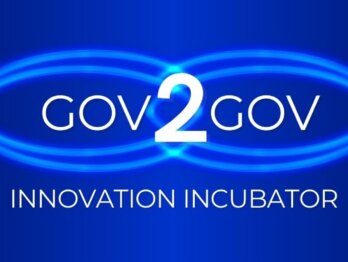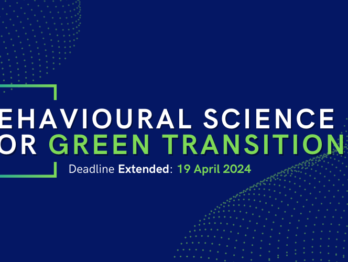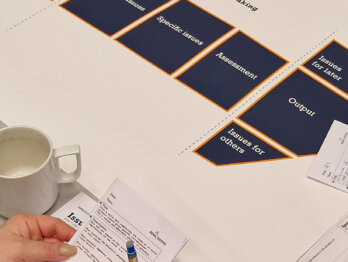The Diversity of Design Toolkits in the Public Sector

Christian Bason, Ph.D., is the CEO of the Danish Design Centre
Editor’s note: The OPSI has partnered with the Danish Design Centre to further explore the application of tools and methods to public sector challenges. This article explores the varied spectrum of design disciplines and practices and provides guidance on how to choose the best design method, drawing from the diversity of design toolkits in the OPSI Toolkit Navigator. It also signals what is next for design in the public sector.
Design is everywhere
In contemporary society, design is everywhere. From the clothes we wear to the cars we drive (or soon will drive us), from the homes we inhabit to the urban spaces we pass through, from the mobile devices and apps we use to the systems enabling them, our world has become the result of millions of human decisions on what to design. Geologists now claim that we live in the Anthropocene: The age of man. Our planet is no longer natural, it is artificial, it has been designed.
As design has reached this saturation point, not least through the proliferation of physical objects and expressions, the professional field of design has itself begun to undergo significant changes. Forms and objects of design move towards services and systems, design practice is changing with new notions of radical end-user and stakeholder involvement, and with new ideas about the contributions of design to the theory and practice of management, organisation, and policy making. Design is further being redefined by technological and social megatrends, which have significance for how organisations are run, products and services are shaped, and how value is created.
Over the past 10-15 years this has given rise to the concept of design thinking, which can be viewed as a way to share the professional work practices of designers – human-centred, visual, experimental, iterative – with a non-design audience: Managers and employees that are not professionally working with innovation, but who can benefit from applying certain design practices to their work. The rise of design thinking as a general approach to managing creative processes in organisations has been remarkable. It has led to millions of employees being trained in design methods, and to a major consolidation of the agency field of design, with technology companies like IBM, Accenture, Wipro and SAP alongside all the leading management consultancies acquiring boutique design firms and investing heavily in recruitment of designers – not least those with digital savvy.
As part of this development, design has been finding its way into the public sector.
Design in the public sector
On the face of it there is nothing new to design in the public sector. Societal institutions – ministries, agencies, cities, universities, schools, libraries and other public bodies – have always related to design through their choice of architecture, industrial design, and visual communication. Think of public buildings, bus stops and logos. Think of all the forms, shapes and symbols associated with the state, with authority, power and with the exercise of administration. Think of design as conveyor of the identity and meaning of the state.
However, just like the broader field of design has splintered and expanded into many new directions as a reflection of our hyper-complex society, so has the use of design in the public sector changed. From traditional industrial age design (which still remains relevant) as a reflection of classic public administration to design for the digital age as a reflection of more networked approaches to governance.
Over the past ten years or so, governments of all types, and on all continents, have increasingly embraced design as an approach to innovation and change within their organisations, and in their interactions with citizens, enterprises and other stakeholders. The rise of design is, thus, tightly linked to the push for more innovative ways of running government, spanning from the design of citizen-facing services to processes for policy making. The rise and scaling of design has cut across four levels of government:
- Local government, where design work focuses on interactions with citizens and draws on methodologies in service design. Examples include cities and municipalities which deploy designers to generate user insights and help local officials redesign services and offerings.
- Regional level, where design has been used amongst others to stimulate new thinking and approaches to economic and regional development, for instance by strengthening the creative sector.
- State level, where design work increasingly spans from service design to comprehensive national digital design programs to embedding design methods directly in the policy making processes.
- International level, where institutions from the EU to the UN have embraced design as a way to address complex policy issues and (for instance in the case of the UNDP) create distributed innovation resources to empower local efforts at country level.
There are several reasons why design has been attractive as an innovation approach in the public sector:
- First, the emphasis on engaging people. Governments, as the administrative institutions they are, continuously strive to connect in more direct and relevant ways to citizens; both in terms of insights (to inform policy and service design), and in terms of the ability to communicate clearly the intended value of new initiatives (policy and service implementation). The inherent human-centred approach in design practice provides a range of practical methods and processes whereby public organisations can deliver on the desire to become more “citizen-centred”, shaping activities and services around what makes sense to people in their own context.
- Second, future approaches: As a future-oriented, integrative practice, which focuses on new opportunities derived through imagination, modelling, experimentation and visioning, design as a professional field provides a much-needed antidote to the heavy reliance on past data (evidence), analysis and problem-orientation. That being said, a key aspect of design work is the emphasis on problem definition (framing), which enables decision-makers to challenge and often redefine their assumptions about a problem space.
- Third, managing complexity: Design practices fit well with the complex multi-stakeholder landscape within which most government organisations operate. With its emphasis on integrating many different perspectives (including different bodies of knowledge, competencies, professions, stakeholders and interests), design offers tangible ways of dealing with the on-going pressure of inclusivity and strategic collaboration.
- Fourth, systematic methods: Design, as opposed to more loosely formulated terms like ‘innovation’ or ‘creativity’, offers well-described methods and tools that can be readily adopted by non-design actors in the public sector and adapted to the sectors’ particular needs. The proliferation of design toolkits, methods collections, guides and so forth is a case in point.
The diversity of design toolkits
As design has evolved over the past decade and been manifested in virtually all sectors and parts of society, there has been a growing need to make the approaches and methods involved explicit.
This has given rise to hundreds of different toolkits – the present toolkit navigator is proof of this. There exists a huge diversity of design toolkits – however, all design toolkits seem to be either generic or developed based on a specific innovation project. Further, they are either strategic (“What is the problem?”) or project oriented (“We need to solve this problem”).
Thus, one might very well argue that there is a growing need for a toolkit to assist you in identifying the right design toolkit. A method for selecting the method, so to speak.
As many different design methods often can be relevant and applied to problem identification, insight generation, ideation and concept development, most toolkits consist of several methods and approaches related to the different phases in the design process.
The best approach to choosing a design tool is to test it. But the complexity when choosing a toolkit is a difficult task and requires a certain kind of maturity and ‘know how’ in this field to navigate through more than 250 different toolkits in the toolkit navigator.
Describing how the identified toolkits have evolved and differentiated over time
Taking a cross-section view, we see that the identified toolkits range from highly generic design toolkits to experience or case-based toolkits.
Generic design toolkits include: Design Method Toolkit, Danish Design Center Toolbox, The Design Thinking Canvas
Experience based design toolkits include: The DIN model, SISCODE toolkit, Design for Policy
Meanwhile, as design has been accepted as an approach to addressing complex and systemic challenges, more design toolkits have been developed and published to facilitate these processes.
In the Danish Design Centre, we identified a number of emerging trends as we analysed the portfolio of the newest design toolkits.
One set of kits related to the need to manage systematic development and collaboration in the context of digital government. Over the past decade alone, governments around the world have embraced digital services to an unprecedented extent and made important strides not only in bringing new technology to the inner workings of public administration, but really leveraging digital solutions to make public services simpler, more accessible and effective for citizens. As a case in point, several of the most-downloaded apps on the Apple app store in Denmark in 2020 were government-developed apps, including apps in space of health and personal finance. Countries like the UK and Canada have made impressive improvements in the scope and depth of digital government services, driven by service design. Thus, design approaches for digital government focus on how to build effective partnerships and draw in equal measure on design thinking and classical design methods. These approaches will always be valuable to meet new challenges and include toolkits such as: 18F Method Cards, P.ACT – Partnership Co-design Toolkit, Tools for Change
Another set focused much more clearly on challenges around sustainability, sustainable development, the green transition and the circular economy. Sustainability is not new to design, of course, but the need for sustainable solutions is becoming widespread. Until recently the emphasis in the design field was on how to enable more sustainable product (industrial) design, for instance through the use of new materials based on sustainable sources. However, over the past decades, the relevance of design approaches to creating environmental impact has increased dramatically. Today, design has become a key approach to systemic change when it comes to achieving long-term impact such as reaching the UN sustainable development goals. Sub-disciplines include the design of new value chains in the context of the circular economy, design for (sustainable) behaviour change, distributed design to enable local and more sustainable manufacturing (drawing on open source innovation and new manufacturing technologies), and using connected design via IoT and data to improve the efficiency of products (such as minimising water waste through measurement inside water pipes). Design has also been leveraged to drive innovation challenges in this field, bringing the skills, methods and tools to contestants bringing private sector solutions to public problems.
Toolkits in the sustainability space include The Circular Design Guide, and CIRCit Workbooks
Design toolkits have also proliferated in the future design / speculative design / scenarios area. Here, design approaches do not immediately lead to solutions or answers but trains participants to deal with uncertainty and enables decision-makers to make more sound choices in the face of an unpredictable future. In this space, design is combined with the broad field of foresight, which traditionally has been very analytically driven. With design methods, innovation practitioners bring at least three new aspects to the foresight field. First, user-centredness, which means that there is a strong emphasis on exploring how particular people would act and make sense of alternative future worlds. Second, storytelling, including through visualisation and enactments, brings detail, richness and life to the scenarios. And third, design methods allow the scenarios to be developed, experienced and utilised in a collaborative, strategic manner that can lead to concrete new initiatives.
Toolkits connecting design to foresight include: Our futures, The Thing From The Future, Living Futures
What’s next for design in the public sector?
Design is at a crossroads. There is the possibility, as some academics have argued in recent years, that design is a “foreign” approach to the public sector, and that it will recede as an approach to innovation in government. The argument is that design is fundamentally a private sector methodology fit for branding and product development, and not for the character of public problems. A counter argument, as discussed in this article, is that design has always been leveraged by public institutions as a way to communicate and manifest themselves to the public. With the rise of a digital, networked, turbulent and complex society, design has morphed and changed along with the needs of organisations to not only adapt but to reframe challenges, work with multiple stakeholders, and innovate new and more powerful ways of creating public value. So far, on balance, design has kept up. As our review of toolkits illustrate, there is an expanding set of domains within government settings where design is applied, and design is increasingly combined with other approaches to change in order to render them more effective. This might be called “design plus”: The integration of design with other innovation approaches.
So, it is likely that we have only seen the beginning of the proliferation of design across the public sector. This begs the question: What’s next? Well, here is a tentative list of some of the most current developments:
- Evidence-based policy: Especially in the health and social sectors, there is a strong tradition for relying heavily on well-tested, evidence-based approaches, often based on randomized controlled trials. Pioneers in this field are bringing design methods in the front-end in order to generate new insights and hypotheses as to where to build novel evidence of what works. In this way design becomes a generator of potential new experiments.
- Design ethics: With the rise of data science, machine learning and artificial intelligence, the power of designers to create solutions that are not only rapidly scalable but also able to make decisions on behalf of or about citizens has risen dramatically. This can have great benefits but also comes with some caveats. The most significant may be how those designing new data-driven and intelligent solutions take account of ethics during the development process. For instance, some government institutions have gotten into trouble by misusing citizens’ data or building algorithms that lead to biased decisions. This means that government institutions must think more ethically about how to design new solutions.
- Designing missions: Within innovation policy, “missions” have become a rapidly growing approach to addressing grand societal challenges while stimulating private sector investments and enabling the leveraging of publicly funded research. A mission-led approach to innovation can be enhanced through the use of design methods, which can enable (end) user engagement, directed collaboration, and quick experimentation and testing of new solutions in local contexts.
These three examples are but a growing set of approaches which can be strengthened in terms of user engagement, commitment of stakeholders, and forward-looking dynamism via design.
Basic guidance on how to choose the right design discipline
As I touched upon earlier on, design has had its place in organisations in both the private and the public sector for quite some time now and, naturally, this has led to the development of a vast number of design tools. Therefore, it can be a challenge in itself to find the right tool for the challenge at hand. Design contains a variety of different disciplines and corresponding tools, e.g., industrial design, graphic design, digital design, product design, service design, experience design, strategic design, organisational design and design management.
Before jumping into the large pool of tools, you should consider:
- the nature of your problem: Which types of design disciplines seem relevant? Does the problem appear relatively simple, transactional and limited? Then tools focusing on graphic or product design may be most relevant. If the problem is ill-defined, emergent and complex, maybe then the domain of strategic design, including design thinking and various “design plus” disciplines may be more appropriate. However, always beware of not jumping too quickly to assumptions about “the nature of the problem”. Seemingly simple, or just complicated, challenges may upon closer exploration turn out to be complex after all
- the level of design proficiency in the team responsible for the development process, and the differentiation between the colleagues using the tools and the colleagues getting exposed to the tools. Some tools are easily applicable – others less so. Use for instance the reviews in the OPSI Toolkit Navigator to get a hint of whether it is a tool that is complex or easy to use. Here, it is also appropriate to consider whether you need to draw on outside expertise, such as design or innovation agencies, consultancies, academia or think tanks, to support your work
- choosing one tool is seldom enough, therefore, you should consider how the different tools you apply correspond to and match with each other. Some guidance on this may be found in the article on Process Facilitation and Co-design
- and then you always need to consider how the tool should be adapted to the context you are in. As mentioned, most tools are either generic or very specific. There are some thoughts on this in the article on organisational design which provide some guidance on which aspects of the organisation you need to consider when initiating a design process
Lastly, you should be aware that once you start opening up the problem space – other challenges or possibilities than those you initially thought you should solve may appear.
Ultimately, choosing the right tools and approaches to enable innovation by design – and facilitating the processes all the way to concrete results and impacts – is more art than science. This means that leadership, and leading with the right mindset, becomes critical. Research shows that adopting a “design attitude” in leading innovation is critical in order to get the most out of the various methods and tools. Design leadership boils down to three sets of practices: First, the ability to challenge your own assumptions, and those of the organisation, by allowing new insights from users to drive the direction of the innovation work. This can be called “leveraging empathy”. Secondly, the ability to keep the organisation open long enough to allow the innovation process to breathe – navigating complexity and ambiguity and supporting even prolonged processes of co-creation and concept development through several iterations. Finally, the ability and the insistence to “rehearse the future”, making the future concrete through prototypes and models, and iterative testing. Here it is crucial that the leader supports the process and sees the importance of on-going learning.












